Eco-friendly fencing options like bamboo, salvaged wood, and stone walls protect your yard while allowing wildlife to thrive. Design your barrier with at least 18 inches of ground clearance and a 40-inch height to accommodate animal movement. Add visibility features like reflective tape, create strategic gaps for migration routes, and maintain your fence regularly to prevent hazards. These simple adjustments balance security needs with environmental responsibility, creating harmony between your property and local wildlife habitats.
The Environmental Impact of Traditional Fencing
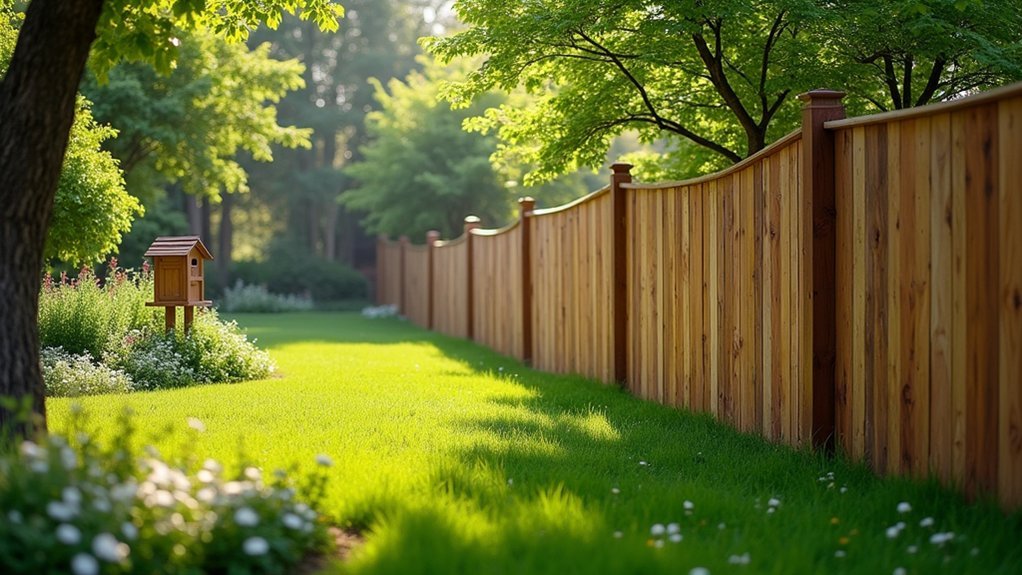
While your garden fence might seem harmless, traditional fencing materials and designs often create significant environmental hazards for local wildlife. When you install barriers using barbed wire or chain-link, you’re creating entanglement risks that injure or kill birds and mammals that attempt to cross them.
Traditional fences fragment habitats by blocking animals’ access to essential resources like food and water. These barriers disrupt natural migration patterns, particularly affecting larger mammals that may impale themselves on sharp edges.
Smaller creatures become trapped, leading to higher mortality rates.
You’re also inadvertently contributing to biodiversity loss when your fencing isolates wildlife populations into smaller areas where they struggle to survive.
Design Principles for Wildlife-Friendly Barriers
When designing your eco-friendly fence, you’ll want to maintain a height of 40-42 inches, allowing animals to jump safely while preventing entanglement in the structure.
You can greatly improve wildlife crossing by ensuring at least 18 inches of clearance under the bottom wire and providing ample spacing between wires for smaller creatures to pass through.
To enhance visibility, which often prevents harmful collisions, consider adding reflective tape or flags to your fence, especially in areas with high wildlife traffic.
Wildlife Crossing Considerations
Since wildlife need to move freely across landscapes to thrive, designing barriers with their movement patterns in mind is essential. Your fence design should respect migration patterns by keeping the top rails below 40 inches and ensuring at least 18 inches of ground clearance at the bottom. This allows wildlife to jump over or crawl under safely.
When planning barriers, prioritize access to essential habitats and travel corridors to prevent population fragmentation. Choose post-and-rail or worm fence designs that create multiple crossing points for various species.
In open areas or near waterways, add visibility markers like flags or reflective tape to prevent collisions. The spacing between wires or beams should be sufficient for smaller animals to pass through without getting trapped or injured.
Visibility Matters Most
Why do animals collide with fences? Often because they simply don’t see them. Wildlife traversing familiar territories can become entangled or injured when encountering invisible barriers. You’ll dramatically reduce these risks by prioritizing visibility in your fence design.
| Feature | Benefit | Implementation |
|---|---|---|
| Flag markers | Makes wires visible | Attach reflective tape every 3 feet |
| Height limit | Allows jumping | Keep top wire under 40 inches |
| Wire spacing | Prevents entrapment | Maintain 12+ inches between wires |
| Bright colors | Improves recognition | Use colored fence components |
Regular inspections guarantee your fence remains wildlife-friendly. Check for loose wires that could entangle passing animals. The most effective fences combine appropriate spacing with high-visibility materials, allowing wildlife to either see and avoid the barrier or maneuver through it safely.
Natural Material Options for Eco-Conscious Boundaries

When creating eco-conscious boundaries for your property, you’ll find salvaged wood offers a second life to materials that would otherwise end up in landfills.
Bamboo barriers provide exceptional sustainability with their rapid growth rate and impressive weather resistance, all while requiring minimal resources to maintain.
For a truly timeless option, consider local stone walls that not only blend beautifully with the landscape but also create microhabitats for beneficial insects and small wildlife.
Salvaged Wood Solutions
While many homeowners focus on new materials for fencing projects, salvaged wood offers a compelling alternative that’s both sustainable and visually striking. By choosing reclaimed timber, you’re recycling materials that would otherwise end up in landfills, greatly reducing environmental impact.
This eco-friendly option doesn’t just benefit the planet—it enhances your landscape with unique character and historical elements that new lumber simply can’t provide. Salvaged wood is typically treated with non-toxic preservatives, ensuring your fence remains durable without leaching harmful chemicals into your soil.
You’ll also support local economies by sourcing materials from nearby demolition projects. The natural texture and varied appearance of recycled wood creates perfect habitats for local wildlife, promoting biodiversity in your yard while establishing beautiful, eco-conscious boundaries.
Bamboo Barrier Benefits
As homeowners search for sustainable fencing alternatives, bamboo stands out as nature’s perfect solution for eco-conscious boundaries. This remarkable grass reaches maturity in just three to five years, making it extraordinarily environmentally sustainable compared to traditional wood fencing options.
You’ll appreciate bamboo’s superior strength, which withstands high winds while naturally resisting pests without chemical treatments. Its lightweight nature guarantees easy installation and reduced transportation emissions, contributing to your property’s reduced carbon footprint.
Beyond practicality, bamboo fencing creates a stunning natural aesthetic that transforms your yard’s perimeter. It also serves as valuable habitat for various wildlife species, enhancing local biodiversity.
With minimal maintenance requirements and impressive durability, you’re investing in a fence that offers long-term environmental benefits and cost savings throughout its extensive lifespan.
Local Stone Walls
Another timeless option to enhance your eco-friendly property perimeter comes from the earth itself. Local stone walls offer a sustainable choice that can last for centuries with minimal maintenance, making them ideal for environmentally conscious homeowners.
You’ll appreciate that these structures require no chemical treatments, greatly reducing your environmental footprint. They’re constructed from naturally sourced materials that support local economies while cutting transportation emissions.
Beyond boundary marking, stone walls create valuable wildlife habitats, providing shelter and nesting sites for small creatures.
When properly built, they maintain ecological connectivity by allowing safe passage for larger animals while still defining your property lines.
Living Fences: Creating Habitat While Setting Boundaries
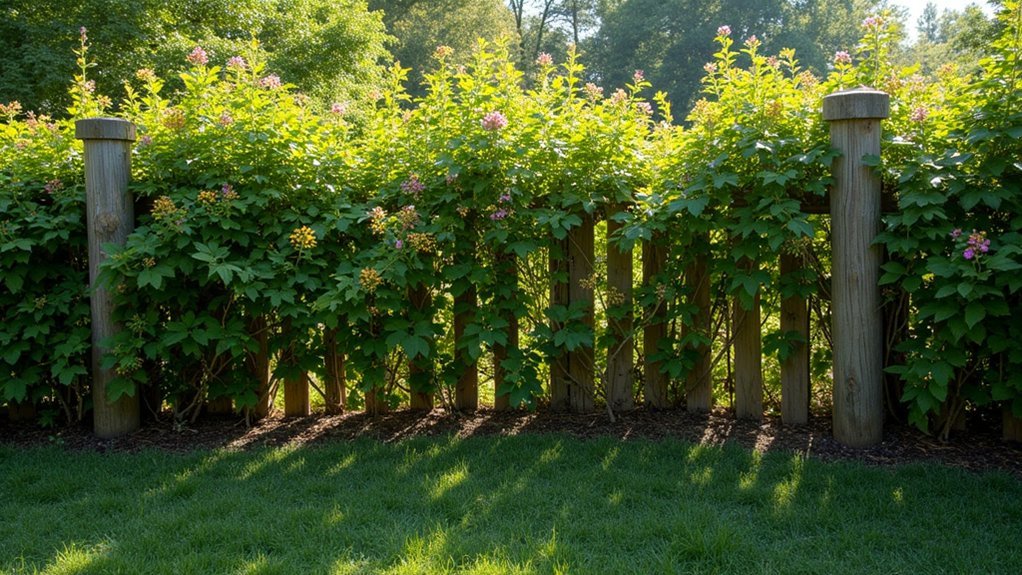
Three remarkable benefits emerge when you choose living fences for your property boundaries.
First, these natural barriers provide privacy while creating habitats that allow wildlife to jump between ecosystems, enhancing biodiversity.
Second, they filter air pollutants and improve your property’s appearance without the carbon footprint of traditional materials.
The importance of wildlife-friendly fencing can’t be overstated—living fences attract pollinators and beneficial insects while supporting local flora and fauna.
You’ll find they’re remarkably low-maintenance, as native plants typically resist drought and adapt to local conditions.
They’ll effectively keep livestock contained while offering food sources for birds and insects.
Unlike conventional options, living fences prevent soil erosion and improve water retention, contributing to a healthier ecosystem around your home.
Maintaining Wildlife Corridors Through Strategic Fence Placement
Strategic fence placement plays an essential role in preserving wildlife movement patterns across your property. When designing your property lines, consider how animals will navigate around your boundaries.
Wildlife corridors allow animals to pass safely between habitats while still defining your space.
- Install wire fences no higher than 40-42 inches with adequate spacing between wires to accommodate different species.
- Create designated wildlife crossings by incorporating gates or drop-down sections along known animal travel routes.
- Regularly maintain your fencing by repairing loose wires and adding visibility markers.
Balancing Security Needs With Environmental Concerns
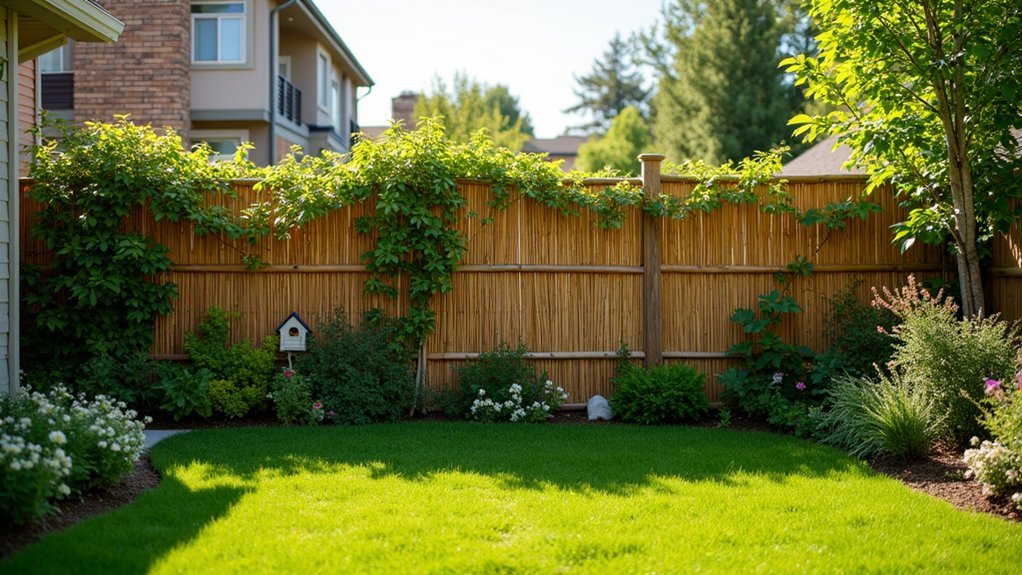
While protecting your property remains a priority, you don’t have to sacrifice environmental responsibility to achieve security. Modern eco-friendly fencing solutions offer robust protection while minimizing ecological impact through sustainable materials like bamboo and recycled composites.
| Fence Type | Security Level | Wildlife Impact |
|---|---|---|
| Living fence | Moderate | Minimal – creates habitat |
| Post-and-rail | Medium | Low – allows smaller animals to pass |
| Wildlife-friendly wire | High | Low – designed for safe passage |
Consider incorporating wildlife-friendly designs with smooth top wires and adequate ground clearance in your fence. These features maintain effective security while allowing natural animal movement. Lower-profile options like post-and-rail effectively deter larger intruders while permitting smaller animals to pass through, creating a balance between protection and environmental stewardship that benefits both your property and local ecosystem.
Seasonal Considerations for Wildlife Movement
Beyond sustainable materials and permeable designs, effective eco-friendly fencing requires attention to wildlife’s changing needs throughout the year.
Your fence should accommodate seasonal migrations that often follow predictable patterns, especially during breeding seasons when animals seek specific nesting sites.
- Create wildlife corridors by strategically placing gaps or crossings that align with known migration routes, ensuring animals can access food and water sources year-round.
- Install raised sections or crawl spaces to provide safe passage for young animals, particularly in spring and summer when they’re exploring new territories.
- Schedule regular inspections during critical migration periods to repair any damage that might create hazards for passing wildlife.
Frequently Asked Questions
What Is the Best Fence to Keep Wild Animals Out?
You’ll need a fence under 40 inches high with 18-inch clearance underneath. Use smooth wire or electrified options for predators, and add visibility markers. Don’t forget regular maintenance for maximum effectiveness.
What Is the Most Sustainable Fencing Material?
Bamboo’s your most sustainable fencing choice. It grows rapidly with minimal water, requires no chemicals, and withstands harsh weather. Don’t overlook composite fencing made from recycled materials or living fences that enhance biodiversity.
What Is Wildlife Friendly Fencing?
Wildlife-friendly fencing allows animals to move freely while maintaining boundaries. You’ll want designs that are 40-42 inches tall with smooth wires or rails and visibility markers. They’re essential for preserving natural habitats and migration routes.
What Fencing Is Nature Friendly?
Nature-friendly fencing includes smooth wire designs with 40-42 inch heights, living fences made of native plants, and structures with visibility markers. You’ll want to avoid barbed wire and guarantee regular maintenance for wildlife passage.
In Summary
Your fence choice matters more than you might think. By selecting eco-friendly materials, incorporating wildlife passages, and thinking seasonally, you’re creating boundaries that protect both your property and local ecosystems. Whether you’ve opted for living hedges or sustainably harvested wood, you’re helping maintain essential wildlife corridors while still securing your space. It’s a small change with significant environmental benefits for years to come.
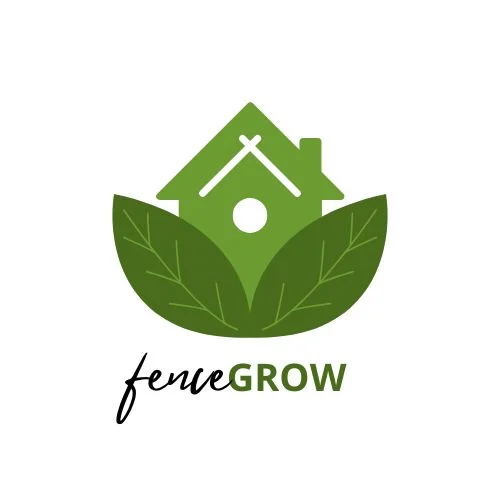
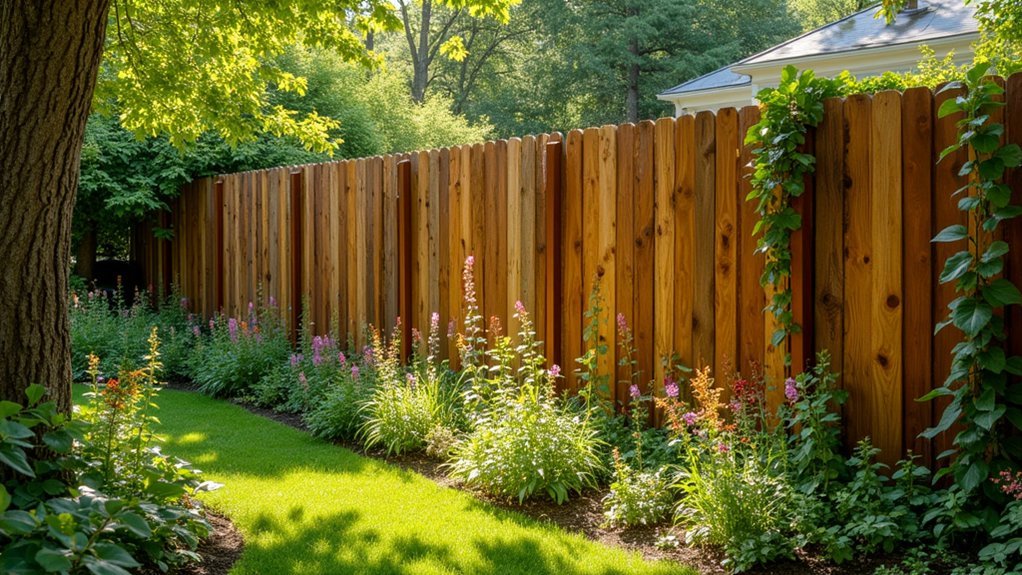

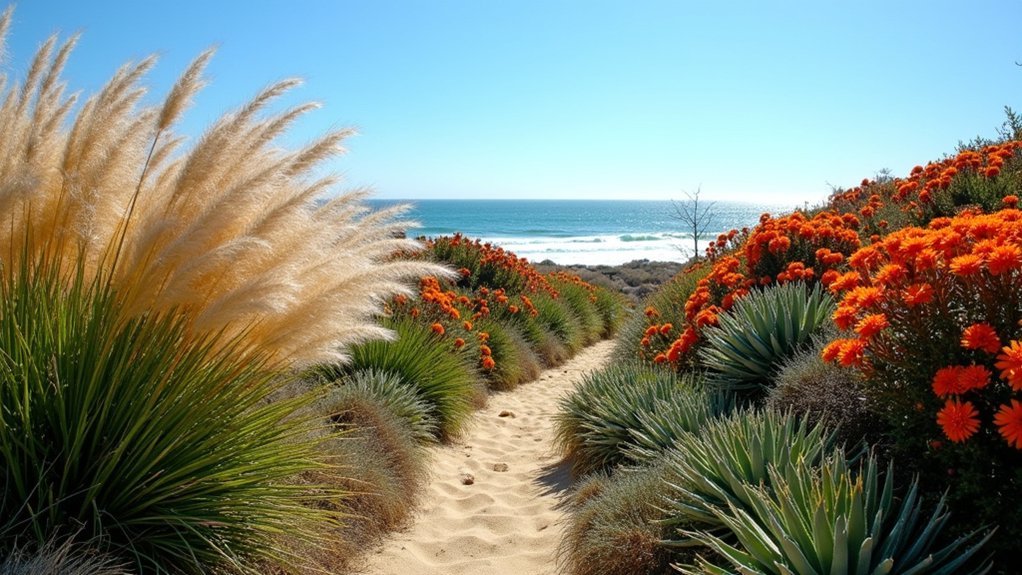
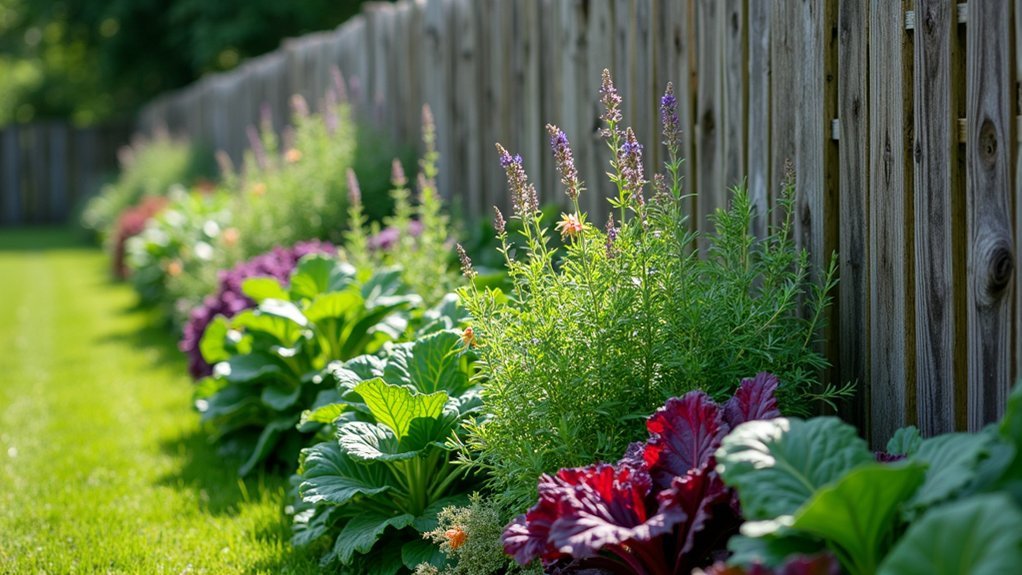
Leave a Reply